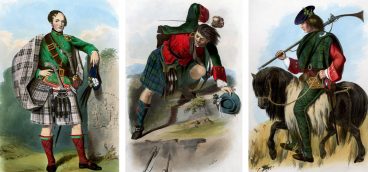Lady Jean

As I dutifully did every morning, I listened to my overnight voicemails. My boss was saying something like this: “Stop what you’re doing and get yourself to the Isle of Arran, and don’t dilly-dally!”
Huh? I’d recently returned from an ill-fated trip to the Hopi Tribe in Arizona and I was a bit touchy on the subject of oddball assignments.
Still, a boss is a boss is a boss, just like a rose is a rose is a rose, so I grabbed my trusty World Atlas and found the Aran Islands, right there in Galway Bay on the west coast of Ireland. They make Aran Isle sweaters there, as you probably know.
I picked up the phone, called my travel agent, and asked how one got from Pittsburgh to the Aran Islands without dilly-dallying.
In the midst of this conversation I noticed that my secretary, Jennie, was waving her arms frantically at me and mouthing something. Not being a lip-reader, I put my travel agent on hold and said, “Now what?”
“It turns out,” said Jennie, “that there’re two Isles of Aran.”
“Let me call you back,” I told the long-suffering travel agent, and looked at where Jennie was pointing on the atlas. Sure enough, there was another Isle of Arran—two Rs—this one located in the Firth of Clyde on the other side of Ireland, close to Scotland.
It eventually turned out that it was, in fact, this second Isle of Arran—the one where they don’t make sweaters—that was the right one. I booked my trip and called my boss to tell her what day I would arrive on Arran. Her briefing to me about this assignment was, in its entirety, as follows:
There was a woman on Arran I needed to see, namely, The Lady Jean Fforde, who owned the island.
I was to treat Lady Jean with all due respect because she was the daughter of the Duke of Montrose and the granddaughter of the Duke of Hamilton.
There was some emergency on Arran. My job was to sort it out, get to the bottom of it, and fix it.
And don’t dilly-dally.
I dutifully flew from Pittsburgh to New York, from New York to London, and from London to Glasgow. I rented a car and drove southwest (on the wrong side of the road) to the small village of Ardrossan, from where one could get a ferry to Arran.
That is, one could get a ferry to Arran if one had arrived in time for it, which I didn’t. So I spent the night in the Scottish version of a Motel 6.
The next day I stood on the dock, staring out at the North Sea and listening to my heart sink. I get seasick very easily, and a strong gale was blowing out there on the Firth of Clyde. The ferry, coming down from Glasgow, was bobbing like a cork. This was going to be a very, very bad crossing.
People who get seasick learn to take measures. One of these is to place yourself in the exact center of the boat in all dimensions, because that’s where the least movement will be. On this particular ferry, the center was on the third deck down, exactly amidships.
Down there, there was a bench against the wall, there was a bunch of very old-fashioned farm equipment, there were sacks of what seemed to be oats, and there were two sheep. And me.
Since there were no other people around I decided to lie down on the bench, thinking that perhaps I could take a nap and thereby die painlessly of motion-sickness in my sleep. I must have nodded off, because when the ferry hit the dock at Arran an hour later I nearly fell off the bench.
I climbed off the ferry looking very green and feeling like I wanted to die. I glanced around dully for Lady Jean’s son, Charles Fforde, who had promised to meet me. Sure enough, there he was, waving gaily to me across the dock.
Unfortunately, Charles wasn’t meeting me with a smooth-riding limousine. No, he had decided to give me a taste of local color, so he was driving a two-wheeled ox cart, looking like the sort of thing they drove Marie Antoinette to the guillotine in.
I climbed reluctantly aboard and off we went, rocking this way and that, rolling that way and this, until my face was the color of Kermit the Frog. We reached Lady Jean’s home, called Strabane (pronounced “straw-BAHN”) and I climbed out of the cart and waved goodbye to Charles, who was heading for the stable.
I walked unsteadily down the front path toward the door, taking deep breaths to avoid upchucking. Suddenly the door exploded open and Lady Jean burst forth, arms spread wide in greeting.
No one had bothered to tell me that Lady Jean was over six feet tall and built like a refrigerator. She had donned her official robes in my honor—Lady Jean sat in the House of Lords—so that, altogether, it appeared to me that I was being attacked by a human giantess.
As though all of this weren’t bad enough, Lady Jean was followed out the door by the most loathsome odor I had ever encountered. And that was the last straw—I threw up all over the robes of the House of Lords.





